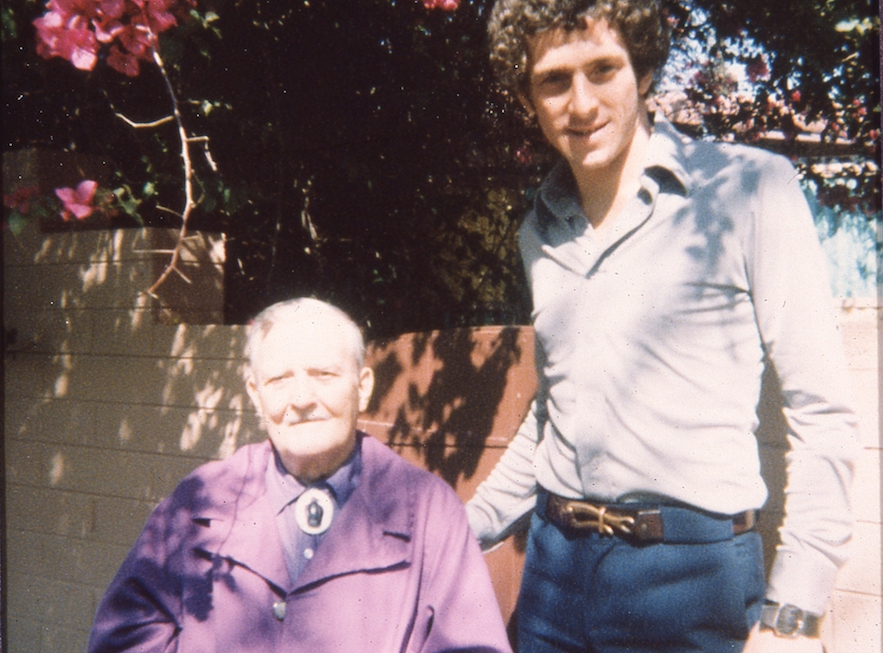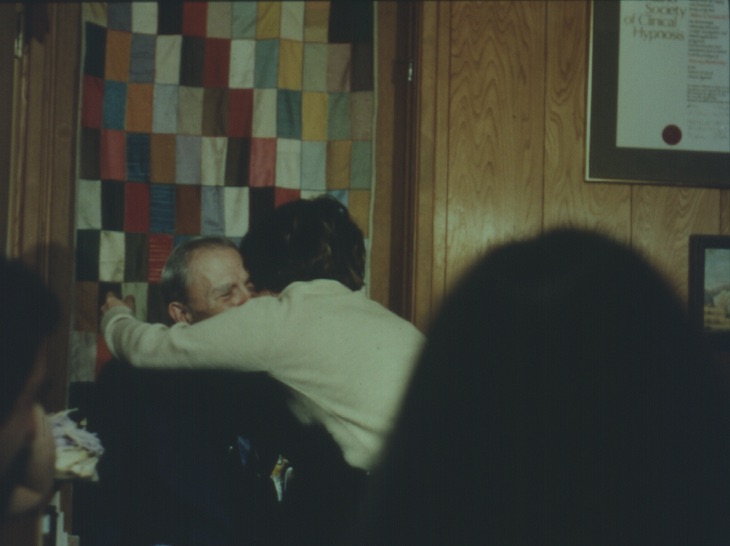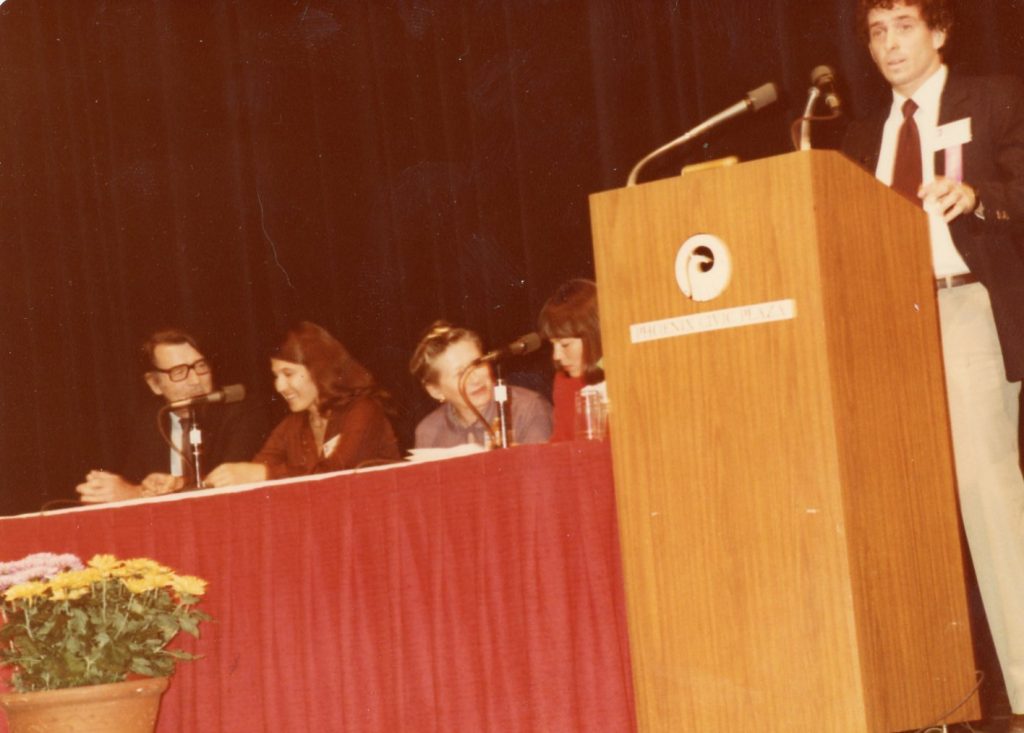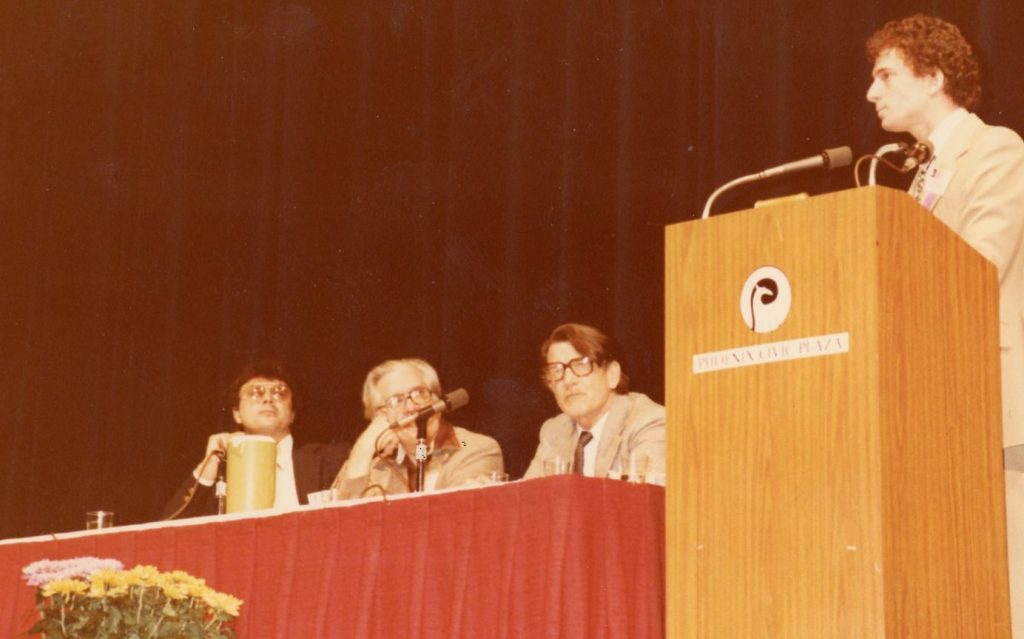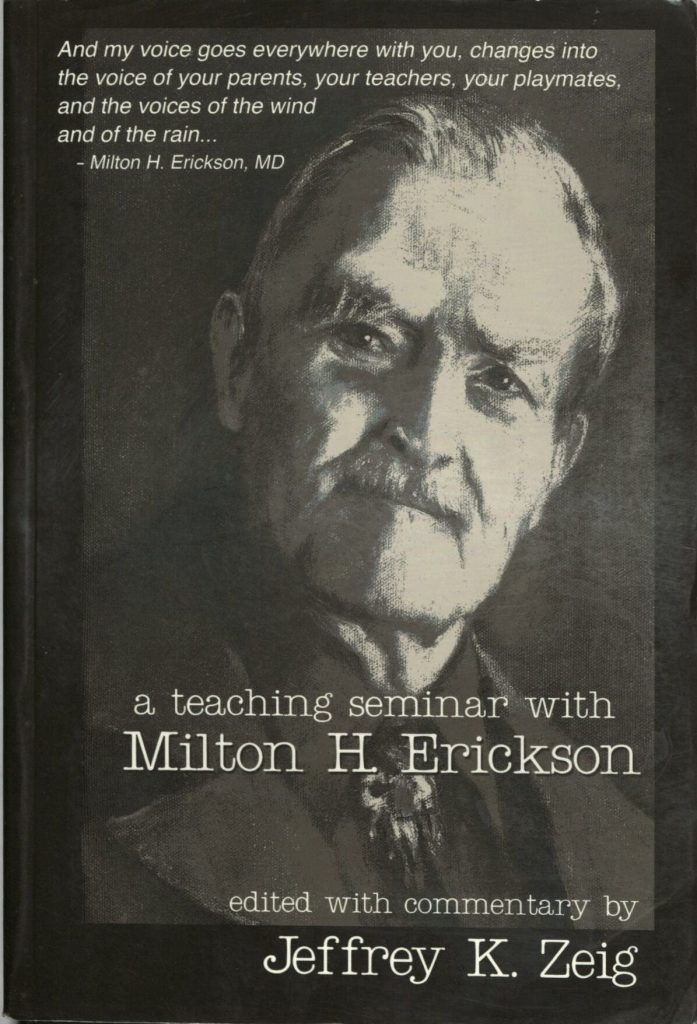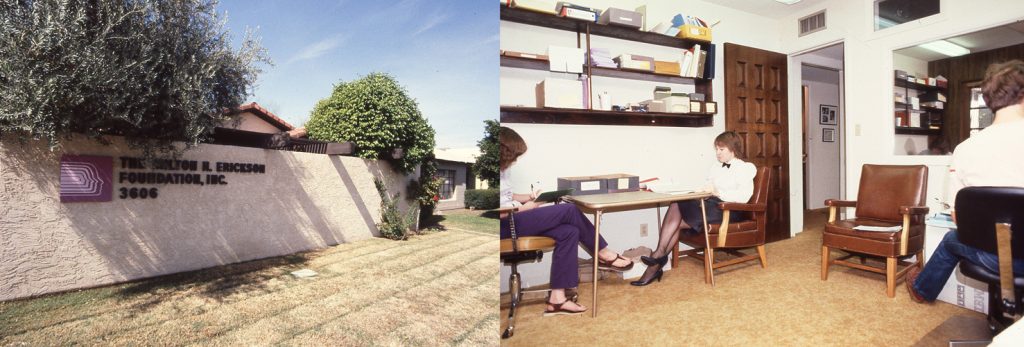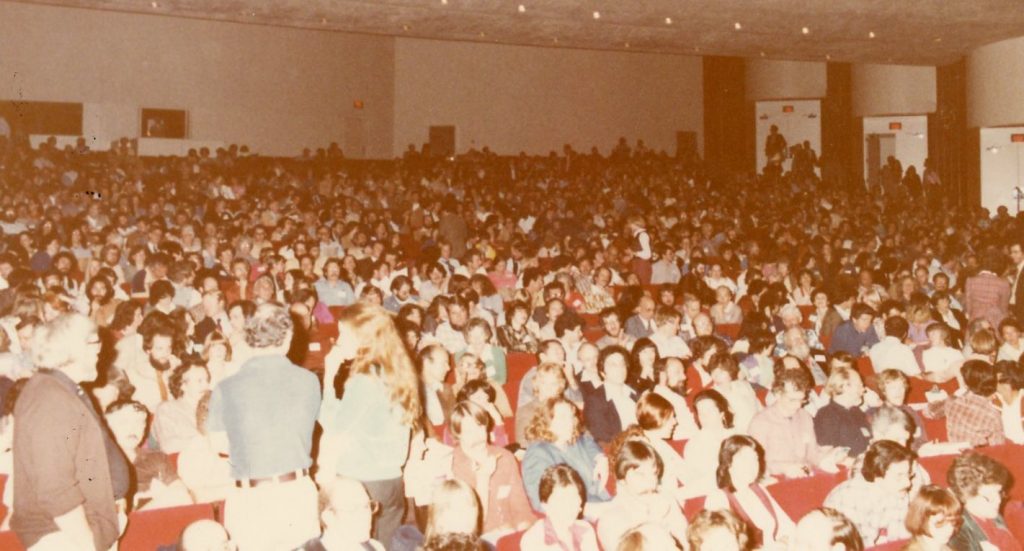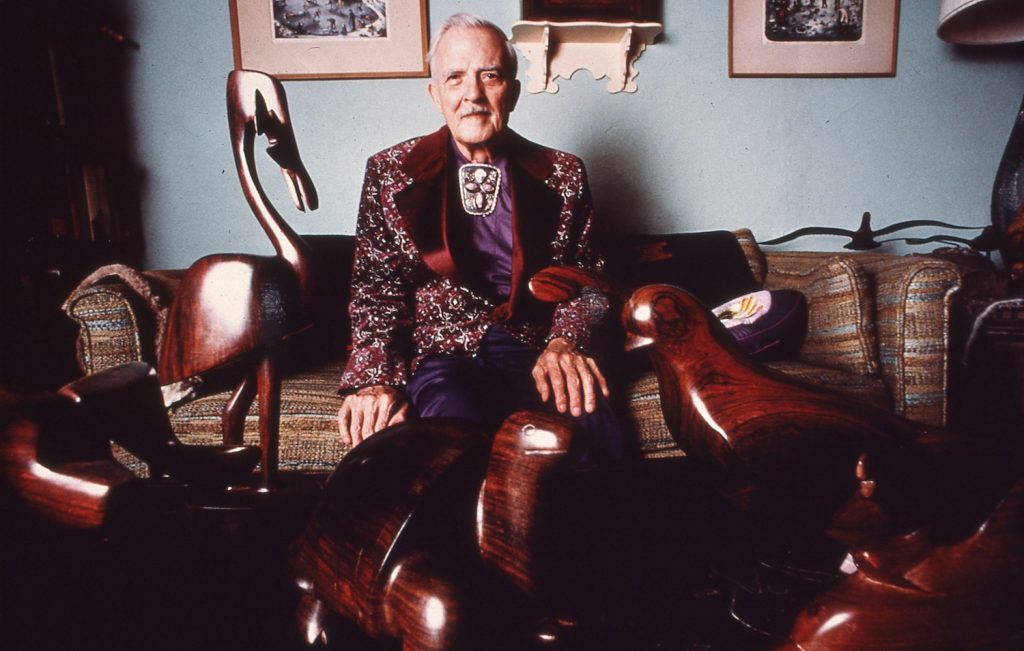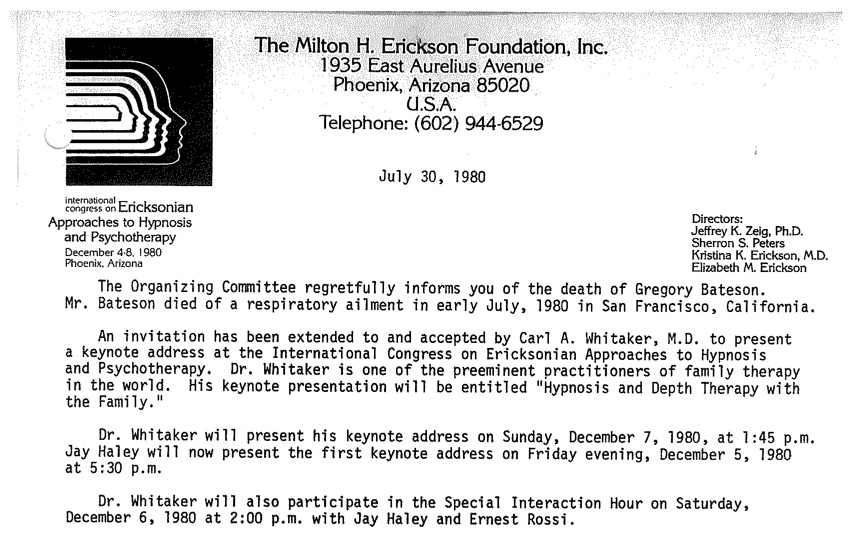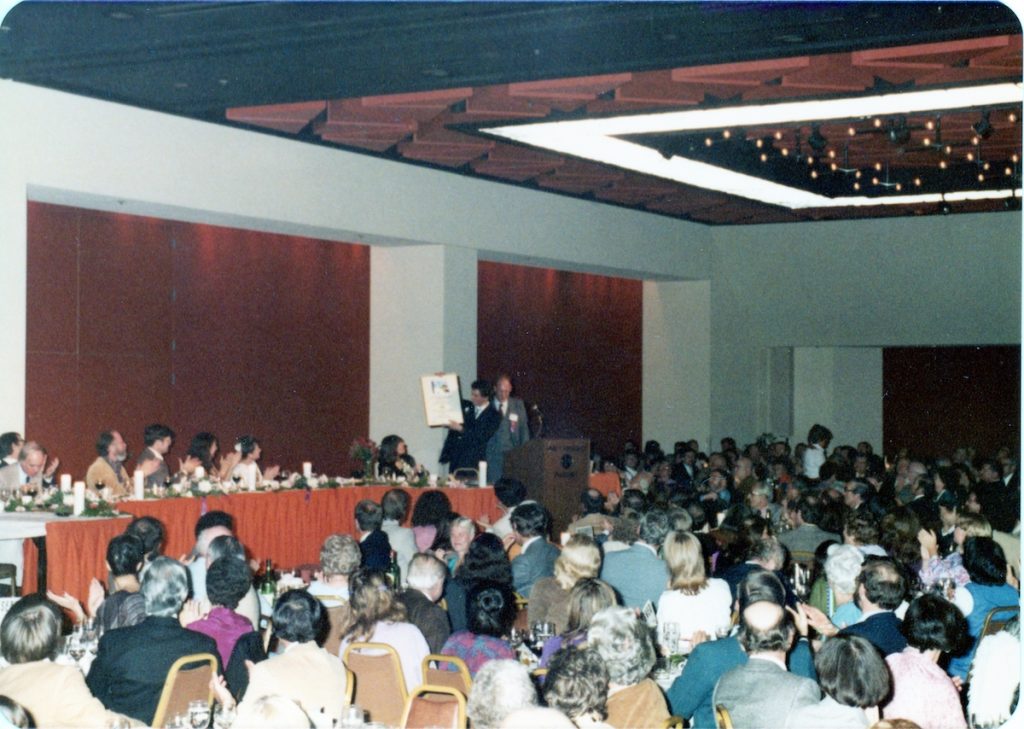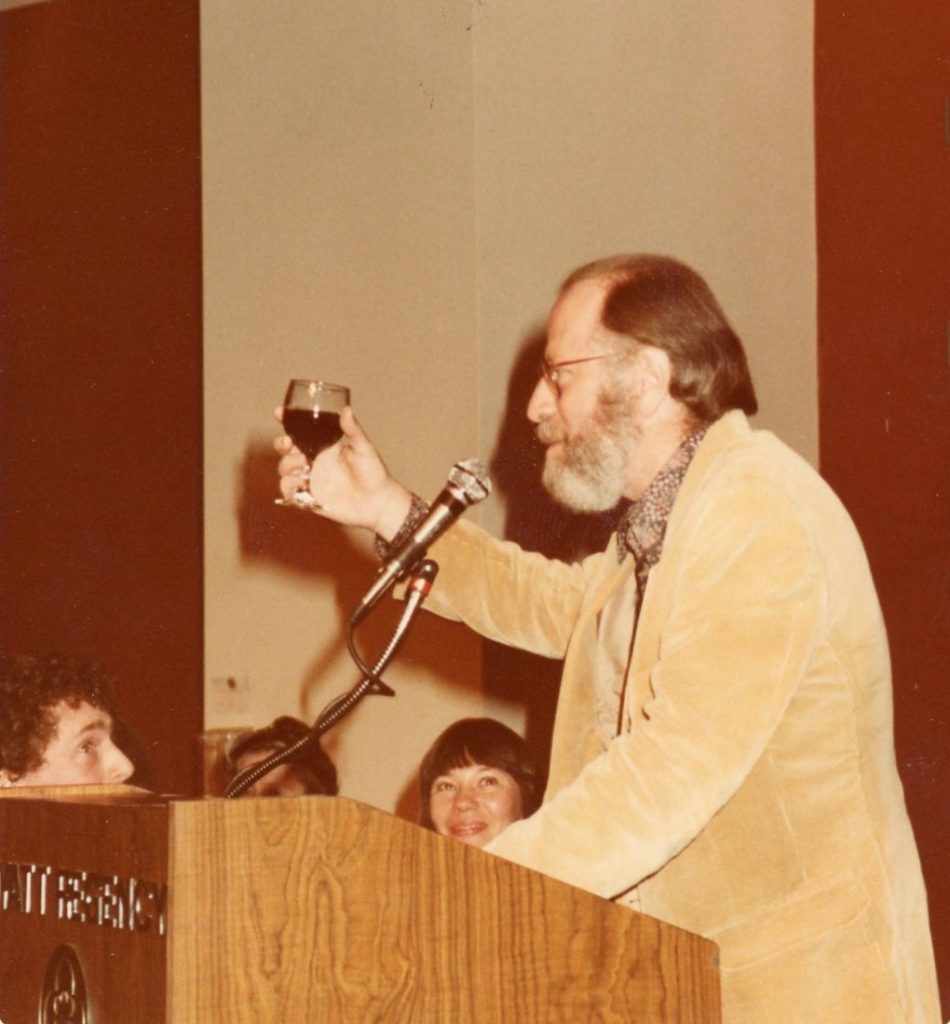History of the International Congress
on Ericksonian Approaches to Hypnosis and Psychotherapy
Written by Sherron S. Peters
Originally published in “Ericksonian Approaches to Hypnosis and Psychotherapy”, pages xv to xx
Join us at the Erickson Congress
this December 12-15,
in Phoenix, Arizona
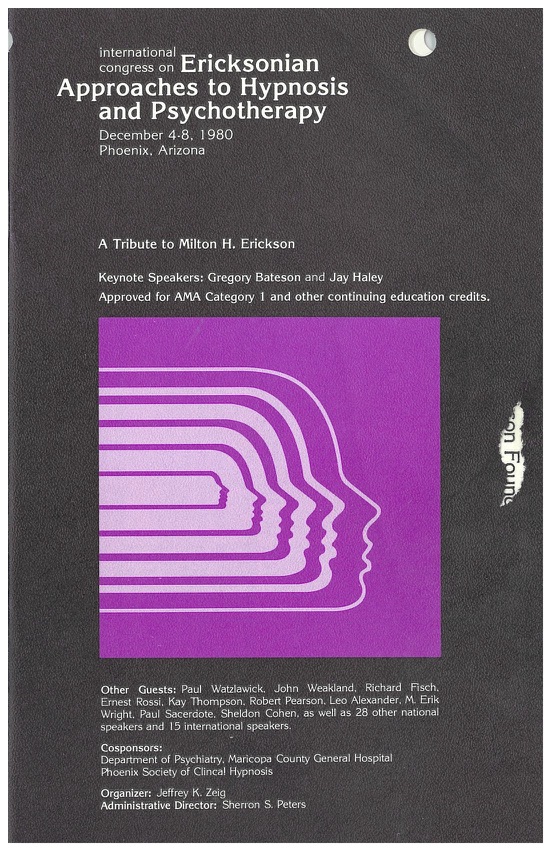
The International Congress on Ericksonian Approaches to Hypnosis and Psychotherapy began as the vision of a student who traveled great distances many times to study with Milton H. Erickson, M.D. With each visit, the student left hungry to learn more and anxious to visit again. Erickson was generous with his knowledge and time. Realizing the student had little money for training, Erickson made no demand for payment, and even opened his guest house so the student could avoid lodging expenses.
For six and one-half years the door remained open. It became clear to the student that in this too brief period Erickson had sown the seeds that would grow to yield a lifetime of knowledge. Grateful, and knowing he could never repay Erickson, the student committed himself to pass on knowledge in the same spirit as it had been given to him.
The student, Jeffrey K. Zeig, Ph.D., began fulfilling his promise by organizing the International Congress on Ericksonian Approaches to Hypnosis and Psychotherapy. Intended to be a tribute to and celebration for Erickson, the Congress was conceived with several goals in mind.
First, through the Congress interested professionals would be provided with an exceptional opportunity to learn about Ericksonian techniques, not only from international experts, but from Erickson himself.
Second, the Congress was scheduled to coincide with Erickson’s 79th birthday, and was intended to be a birthday celebration, with the invited speakers being his long-time friends and colleagues.
Third, through those attending the Congress, Erickson would be offered the tribute of witnessing the dramatic impact of his life’s work.
In March 1979 Jeff requested permission from Erickson to hold the Congress. While Erickson didn’t reject the idea, he certainly didn’t approve it readily. Following the March proposal, Jeff approached Erickson many times to see if he had reached a decision, and it began to appear that Erickson didn’t want the Congress to take place. In retrospect, it seems more likely that Erickson wanted to insure sufficient initiative and motivation in Jeff to complete such an enormous task, because not until June 1979 did Erickson give his permission.
Dr. and Mrs. Erickson were part of the organizing committee and, with Jeff, selected the speakers to be invited. As Jeff’s fiancee, and because of my background in business, I joined the group as Administrative Director.
Initially, the selected faculty consisted of about 30 people. However, as the Ericksons became more interested and excited about the project, the number of invited presenters quickly grew from 30 to 63 people. As well as having recognized expertise in Ericksonian hypnosis and psychotherapy, each invited speaker was a friend, colleague and student of Erickson. Together they were to comprise the most gifted faculty ever to speak on the topic of hypnosis.
It was a humbling experience inviting people like Gregory Bateson, Jay Haley, and the 60 other renowned experts. We were asking a lot of them. Each speaker was to compose a formal paper on Ericksonian hypnosis and psychotherapy suitable for publication. Each was also expected to take part in at least two major events, and to leave his private practice for one week. For what we were requesting we had little to offer in return. We could not pay an honorarium, and only offered to pay partial expenses with the possibility of more being paid if sufficient revenues were generated.
With few exceptions, all who received invitations accepted. Bateson and Haley agree to present keynote addresses. Other speakers offered to do workshops and take part in conversation hours. Two special interaction hours were planned — one consisting of Erickson, Bateson, Haley and Rossi, and the other to include Watzlawick, Weakland and Fisch. Of the 63 Congress faculty, 40 members were from the United Sates and 23 were from 18 other countries.
Having secured the faculty, we established the Milton H. Erickson Foundation to handle all financial arrangements. The Foundation eventually acquired State and Federal nonprofit status. The original Board of Directors of the Foundation were: Dr. and Mrs. Milton H. Erickson, Jeffrey K. Zeig, Ph.D., and myself, Sherron S. Peters.
Financing the project was the next issue to be resolved. We estimated that we would need as much as $10,000 seed money to print and mail preliminary brochures, buy a typewriter and file cabinet and pay legal fees.
Because of Erickson’s growing popularity, Jeff speculated that publishers would be willing to provide a substantial advance against the royalties for the published proceedings of the Erickson Congress. As it turned out, publishers were interested in Erickson books, but were not willing to provide a very substantial advance for proceedings from a Congress that had not been held yet.
Therefore, we had to come up with other ideas for procuring seed money. Jeff had been videotaping Erickson’s seminar classes. Since one of these week-long seminars was of exceptional quality, we decided to transcribe the videotapes of that week into book form, and the idea for the Teaching Seminar book was born. A contract for the two books was finally signed with Brunner / Mazel Publishers, who provided us with an advance sufficient enough to begin the project.
Although the advance from Brunner / Mazel against the royalties of the two books provided us with part of the seed money necessary to initiate the project, it fell short of our financial needs. To generate additional capital, we offered a substantially reduced registration fee for the registrations made prior to March 15, 1980. Brochures advertising the Congress and the early registration offer were printed and mailed in November 1979.
Budgetary limitations precluded our renting or leasing office space. Instead, our home became the headquarters for The Milton H. Erickson Foundation. Two rooms were converted to office space with the intention that they would accommodate both Jeff’s private practice and the Foundation work. However, as word about the Erickson Congress spread and response grew, our entire home yielded itself to workspace. The dining room table became the bookkeeping and advance registration area, while the breakfast nook was used for overflow secretarial work and editing space. The guest room stored files and video equipment. Work lists were taped to the kitchen cabinets and refrigerator. For lack of space, work stacks and filing were placed on the floor around the living room until they could be handled.
Bulk mailings were the most time-consuming and frustrating jobs in the entire Congress preparation. Over 70,000 brochures were mailed. To maintain low overhead expense, all mailings were done from our living room, with the help of a handful of dedicated volunteers who had joined the organizing committee. Each mailing required 15 to 20 hours of boring, hard work.
The reward for the work came in the tremendous response received from interested professionals. Registrations began flooding in from all parts of the country and from around the world. From February to July 1980, it was not unusual to receive 50 to 100 pieces of mail per day.
We had no idea how much interest would be stimulated by the proposed Erickson Congress. In fact, during the initial planning stages of the Congress, two of our major speakers were consulted on the number of attendees we could expect. One suggested that we would be lucky to get 200 people. Another speaker was willing to wager two steak dinners to one that we would receive no more than 750 registrations. By March 1980, we had already received well over 750 registrations and it appeared to Jeff and me that we could look forward to collecting those two steak dinners.
On March 25, 1980, Dr. Erickson passed away. An awesome sense of loss was felt by everyone who had known, loved and respected him. For those of us who had worked on organizing the Congress, it was devastating to realize that he would not be at the Congress, that the banquet held on the evening of December 5th would not be a birthday celebration, and that Dr. Erickson would not be with his friends and colleagues gathering nine months later to honor him and his work. Our consolation was that Erickson died with the knowledge that over 750 people had already registered for the Congress. He had at least a glimpse of the profound impact and interest his work had stimulated around the world.
The death of Erickson raised the question of whether or not the Congress should be postponed or even cancelled. It was felt this decision should be made by the Erickson family, and the organizing committee was prepared to respect and follow through with their wishes. The unanimous decision of the Ericksons was that the December Congress should take place on schedule. Since it was Erickson’s wish not to have a funeral, the family thought it appropriate that the Congress be held as a memorial tribute.
After Erickson’s death, the Erickson family members united to provide their total support of the Congress. They worked many hours notifying each speaker and registrant of Erickson’s death. They assumed total responsibility for sending thank you letters, often handwritten, for the numerous donations made to the Foundation in memory of Dr. Erickson. It was the courage and strength of the Erickson family, together with their help and support, that renewed energies and transformed disappointment into excitement.
Then, in July 1980, another devastating blow came with the death of Gregory Bateson. Bateson, who was a close friend and colleague of Dr. Erickson, was scheduled to present a keynote address entitled “Science or Power.” Bateson was irreplaceable. Once again we were faced with notifying our registrants and faculty of a tremendous loss.
The consensus of several major Congress faculty members was that a replacement speaker had to be found as soon as possible. This was a very difficult task for many reasons. Our faculty already included virtually every available authority on Ericksonian hypnosis and psychotherapy. In addition, the Congress was five short months away, and we feared it might be impossible to find a keynote speaker on such short notice. Consequently, we moved outside the field of hypnosis and Ericksonian technique, searching for a person with a complimentary expertise who would provide a unique vantage point from which to comment on Erickson’s work. In late July 1980, an invitation to present a keynote address was extended to and accepted by Carl A. Whitaker, M.D. As one of the preeminent practitioners of family therapy in the world and as one who shared many philosophies that are hallmarks of Erickson’s work, Whitaker proved to be an excellent choice.
In October 1980 the workload became overwhelming and the volunteers came to our home daily to help complete the endless tasks. Three sources of volunteers filled the ranks. Initially, interested friends in the field of psychotherapy helped with the mailings, served as organizing committee members, and joined the editorial staff for the Teaching Seminar book. The second source was from Jeff’s patients, who became very involved and worked hard on the preparation of the Congress. Those who could not afford to pay for therapy instead donated their time to the Foundation. Some of the these people ran errands while others answered phones. One young man spent days folding and stapling hundreds of brochures. Another young woman worked for weeks to complete a 6’x6’ latchook rug of the Foundations expanding heads logo. The rug was used as a backdrop on the stage of Symphony Hall during the Congress. These people served as monitors at the Congress, and with the exception of one paid professional the entire video portion of the Congress was organized and run by volunteers. In total, 100 people volunteered. It is a tribute to our volunteer staff that the Congress ran smoothly and on schedule.
The Congress began on Thursday, December 4, 1980 with 14 half-day pre congress workshops. On Friday morning, December 5th, seven half-day workshops were held. Some of the workshops were large in size, totaling as many as 500 attendees. The Convocation to the Congress was held Friday afternoon.
Almost half of the registrants attended the Congress banquet and dinner dance held the evening of December 5th. Carlos Sluzki, Director of Mental Research Institute, presented a special toast. Faculty members, representing several international hypnosis societies, made special presentations of tribute to Erickson.
The faculty presented their papers at the General Sessions, which began on Friday, December 5th, and continued through to the afternoon of December 8th. Two General Sessions ran simultaneously. Concurrent with the General Sessions, two conversation hours and two media events were held. The media events included film presentations of Bateson, Whitaker, and Erickson. A biographical slide presentation on Erickson’s life was shown continuously throughout the Congress.
The tone of the Congress was one of cooperative learning. The faculty did an outstanding job in offering attendees a unique and varied learning experience. Through workshops, papers and conversation hours, the faculty presented Erickson’s influence in the fields of medicine, dentistry, psychiatry, psychology, anthropology, and forensics.
Some speakers were still feeling the loss of Bateson and Erickson, and a certain tone of eulogy emerged. Stories of special personal experiences with Erickson were shared by some faculty members. The Congress, being unexpectedly presented within the framework of a memorial meeting, provided attendees with an extraordinarily rare blend of insights into the work, the person, and the genius of Milton H. Erickson, M.D.
The full Congress schedule didn’t provide attendees with much time to see the Phoenix area. However, many who had read Erickson’s work and were familiar with the special meaning Squaw Peak (now known as Piestawa Peak) had in Erickson’s life and therapy too time to climb the mountain.
On the afternooon of December 8th, the Closing Remarks brought the Congress and a year and a half of work to a close. For Jeff and me that day will always have a very special place in our hearts.
